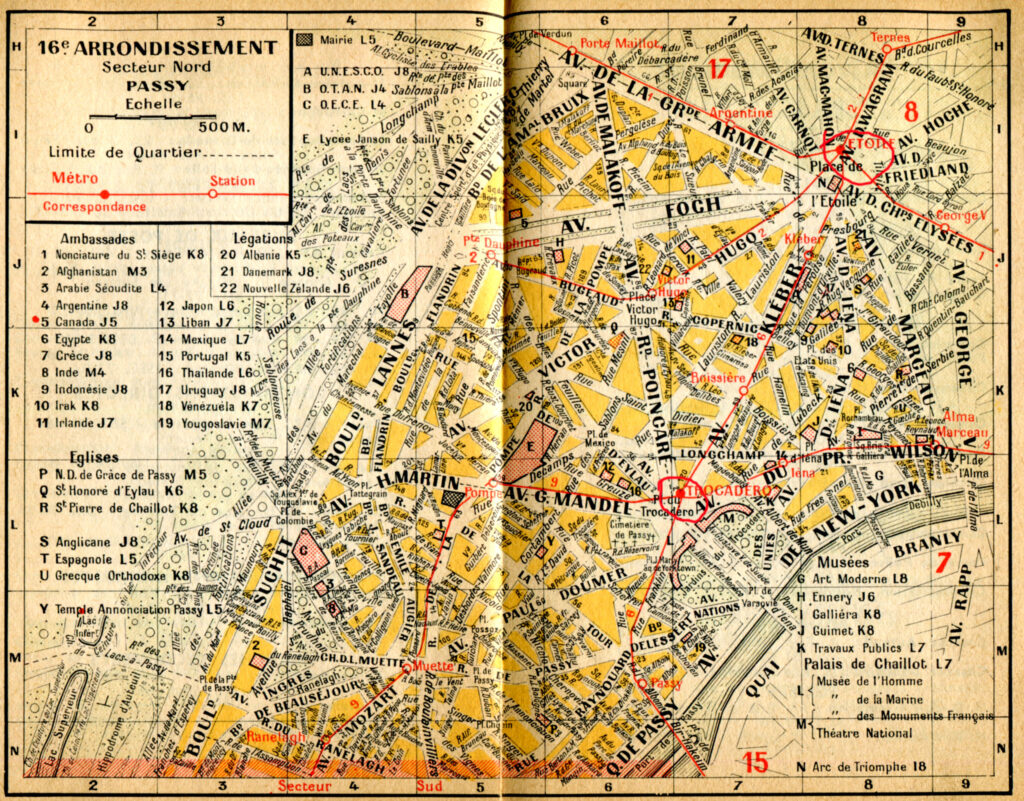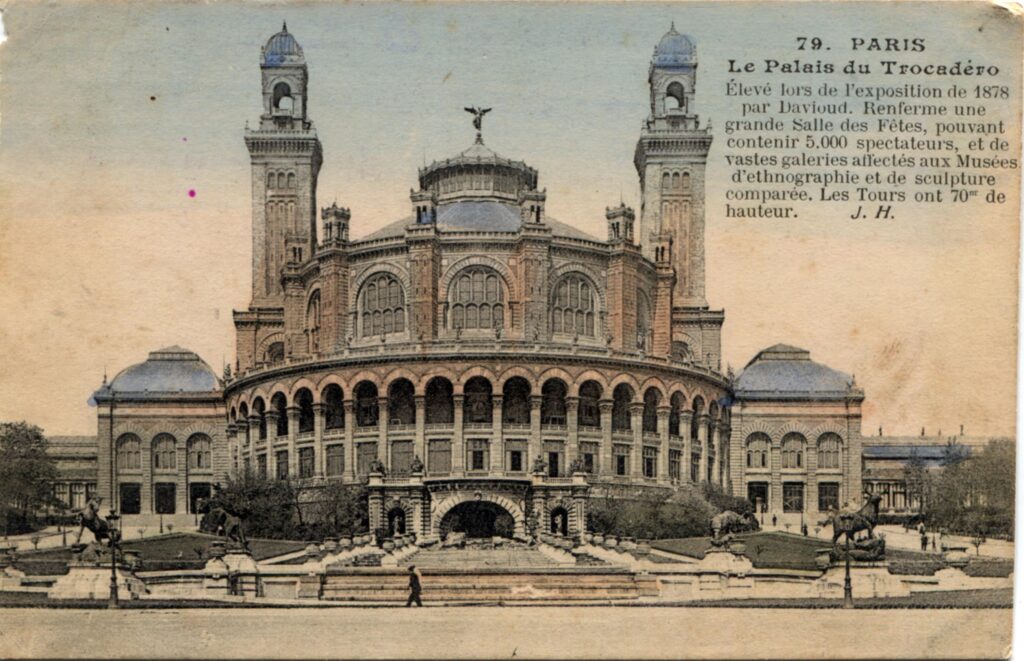Trocadero, site of the Palais de Chaillot, is a district of Paris, in the 16th arrondissement, across the Seine from the Eiffel Tower. It is also the name of an 1878 palace which was demolished in 1937 to make way for Chaillot. Trocadero is also a hill of Chaillot, a former village, now an excellent observation platform overlooking the Eiffel Tower and the surrounding area. Favorite place of all tourists.
Trocadero Palace.
Built for the 1878 Universal Exhibition, the Trocadero Palace included a venue for fairs and conferences. The shape resembled a large concert hall with two wings and two towers; and the style was a mixture of the exotic and the historical, commonly referred to as “Moorish”, but with some Byzantine elements. The architect was Gabriel Daviud.
The “Great Hall for Holidays” was opened, accommodating up to 5000 visitors and spacious galleries presenting exhibits of the Museums of Ethnography and sculptural compositions. The towers were 70 meters high.
History and description. The hill of Chaillot was first built for the World Exhibition of 1867. For the other World Exhibition of 1878, the (old) Trocadero Palace (1878-1936) was already built here (where meetings of international organizations could be held during the fair). The palace was shaped like a large concert hall with two wings and two towers; his style was a mixture of exotic and historical references, commonly referred to as “Moorish” but with some Byzantine elements. The architect was Gabriel Davioud.
The concert hall had a large organ made by Aristide Cavaillé-Coll; the first large organ to be installed in a concert hall in France (it has been modified twice since then and eventually moved in 1977 to the Auditorium Maurice Ravel in Lyon, where it is still in use today). The organ was inaugurated at the 1878 World’s Fair with a concert at which Charles Marie Widor premiered his Organ Symphony No. 6. The building proved unpopular, but the cost of its construction delayed its replacement by nearly fifty years.
Under the building, on the site of former underground quarries, a large aquarium was built for fish from French rivers. It was renovated in 1937 but closed again for renovation from 1985 until May 22, 2006. The space between the palace and the Seine is surrounded by gardens designed by Jean-Charles Adolphe Alphand and many fountains.
In the garden of the old palace were two large statues of animals, a rhinoceros and an elephant, which were removed and preserved during the demolition of the old Trocadero palace and since 1986 have been located near the entrance to the Musée d’Orsay.
Interesting tourist facts.The place was named after the Battle of Trocadéro, in which the fortified island of Trocadéro in southern Spain was captured by French troops led by the Duke of Angoulême, son of the future King Charles X of France, in August. On January 31, 1823, France intervened on behalf of King Ferdinand VII of Spain, whose rule was challenged by a liberal uprising. After the battle, the autocratic Spanish Bourbon Ferdinand VII was restored to the throne of Spain.
François-René de Chateaubriand said: “To pass through the lands of Spain in one fell swoop, to succeed where Bonaparte failed, to achieve victory in the same land where the hands of a fantastic man failed, to do in six months what he could not do in seven years, it was truly amazing!”
World War One. The square is now officially called “Place du Trocadéro et du 11 Novembre” (in honor of the truce of the First World War), although it is usually referred to simply as Place du Trocadéro.
Under the building, on the site of the former catacombs, a large aquarium was built for fish from the rivers of France. The aquarium was renovated in 1937, then closed again for repairs from 1985 until May 22, 2006.
Palais de Chaillot.
For the International Exhibition of 1937, the old Palais de Trocadero was partly demolished and partly rebuilt, and now the Palais de Chaillot sits on top of a hill. It was designed in a classic “modern” style by the architects Louis-Hippolyte Boileau, Jacques Carlu and Léon Azéma. As in the old one, the Chaillot palace has two wings forming a wide arc; Rebuilt and expanded, these wings and a pair of central pavilions are the only remaining part of the former building. However, unlike the old one, the wings are separate buildings and there is no central element connecting them: instead, the wide esplanade leaves an open view from the Trocadero to the Eiffel Tower and beyond.
The buildings are decorated with quotes by Paul Valéry, and the sculptural groups in the attic are by Raymond Delamarre, Carlo Sarrabezolles and Alfred Bottiau. The eight gilded figures on the terrace “Rights of Man” are attributed to the sculptors Alexandre Descatoire, Marcel Gimond, Jean Paris dit Pryas, Paul Cornet, Lucien Brasseur, Robert Couturier, Paul Niclausse, and Félix-Alexandre Desruelles.
The buildings now house a number of museums:
– The National Maritime Museum (Naval Museum) and the Museum of Man (Ethnology) in the South (Passi) Wing.
– Architectural town (Cité de l’Architecture et du Patrimoine), including the National Museum of French Monuments, in the east (Paris) wing, from which you can also get to the National Theater of Chaillot, the theater under the esplanade.
Interesting Facts. It was at the Palais de Chaillot that on December 10, 1948, the General Assembly of the United Nations adopted the Universal Declaration of Human Rights. A stone has now been erected to commemorate this event, and the esplanade is known as “esplanade des droits de l’homme” (“Esplanade of Human Rights”). The Palais de Chaillot was also the original headquarters of NATO, while the “Palace of NATO” (now the Université Paris Dauphine) was just under construction.
The Trocadéro Gardens occupy an open space bounded on the northwest by the wings of the Palais de Chaillot and on the southeast by the Seine and the Pont de Jena.
Gardens and parks. The current garden has an area of 93,930 square meters and was created for the International Exhibition of Art and Technology in Modern Life (1937) by the architect Roger-Henri Expert. The entire area was previously the garden of the old Trocadero palace, laid out by Jean-Charles Adolphe Alphand.
Observation deck overlooking the Eiffel Tower.
Today, this place is an excellent observation deck, a favorite place for tourists from all over the world. This is the shortest way from the nearest metro to the Eiffel Tower.
infamous facts. During the German occupation of France, it was on the front terrace of the palace that Adolf Hitler was depicted during his short tour of the city in 1940 against the backdrop of the Eiffel Tower. It became an iconic image of World War II.
Practical tourist information.
You can visit this place during an independent walking tour from the metro of the same name. For the initial acquaintance, a series of sightseeing tours of the city also passes through this place, in the daytime or in the evening.


